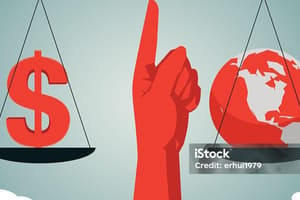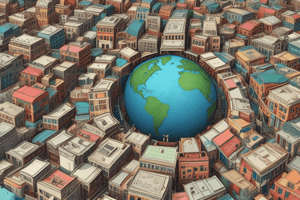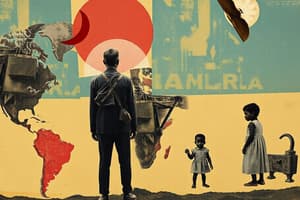Podcast
Questions and Answers
What population percentage owns 44% of the world's wealth?
What population percentage owns 44% of the world's wealth?
- 20%
- 10%
- 1% (correct)
- 5%
Which of the following is NOT included in the mainstream definitions of development?
Which of the following is NOT included in the mainstream definitions of development?
- Environmental sustainability (correct)
- GDP per capita
- Trade flows
- Industrialization
According to critical definitions, which aspect is prioritized in discussing development?
According to critical definitions, which aspect is prioritized in discussing development?
- Market regulations
- Trade balance
- Human needs (correct)
- Economic growth
What is one of the liberal explanations for obstacles to development?
What is one of the liberal explanations for obstacles to development?
Which of the following is a critical approach to understanding obstacles to development?
Which of the following is a critical approach to understanding obstacles to development?
What concept is primarily ignored by mainstream definitions of development?
What concept is primarily ignored by mainstream definitions of development?
Which of the following is an ideological extreme related to development discussions?
Which of the following is an ideological extreme related to development discussions?
What is a consequence of neo-imperialism as discussed in critical approaches?
What is a consequence of neo-imperialism as discussed in critical approaches?
Which of the following barriers to development is highlighted by both liberal and critical approaches?
Which of the following barriers to development is highlighted by both liberal and critical approaches?
Which of these elements is considered a basic human need in critical definitions of development?
Which of these elements is considered a basic human need in critical definitions of development?
Which statement accurately reflects the critical view of Structural Adjustment Programs (SAPs)?
Which statement accurately reflects the critical view of Structural Adjustment Programs (SAPs)?
What is a key component of the Washington Consensus?
What is a key component of the Washington Consensus?
Which of the following accurately characterizes the relationship between agency and structure in development?
Which of the following accurately characterizes the relationship between agency and structure in development?
What is the estimated financial requirement to eliminate hunger globally?
What is the estimated financial requirement to eliminate hunger globally?
Which model of economic growth did the Asian Tigers exemplify?
Which model of economic growth did the Asian Tigers exemplify?
The Monterrey Consensus emphasized which of the following?
The Monterrey Consensus emphasized which of the following?
What is a common critique of capitalism mentioned in the context of development?
What is a common critique of capitalism mentioned in the context of development?
Which obstacle to development is highlighted by both liberal and critical explanations?
Which obstacle to development is highlighted by both liberal and critical explanations?
What role does the UN play in economic development models?
What role does the UN play in economic development models?
What is a characteristic of excessive debt for developing countries?
What is a characteristic of excessive debt for developing countries?
Flashcards
Agent-Structure Debate
Agent-Structure Debate
Examines how individual actions (agency) and broader systems (structure) influence outcomes.
Excessive Debt
Excessive Debt
Large debt that limits a country's choices and puts it under the control of powerful entities.
Structural Adjustment Programs (SAPs)
Structural Adjustment Programs (SAPs)
Economic policy imposed by the World Bank and IMF, emphasizing market liberalization and austerity measures.
Critical View of SAPs
Critical View of SAPs
Signup and view all the flashcards
Asian Tigers
Asian Tigers
Signup and view all the flashcards
Shock Therapy
Shock Therapy
Signup and view all the flashcards
Monterrey Consensus
Monterrey Consensus
Signup and view all the flashcards
Washington Consensus
Washington Consensus
Signup and view all the flashcards
Clean Water Needs
Clean Water Needs
Signup and view all the flashcards
Eliminating Global Hunger
Eliminating Global Hunger
Signup and view all the flashcards
Global Wealth Inequality
Global Wealth Inequality
Signup and view all the flashcards
Development (Mainstream Definition)
Development (Mainstream Definition)
Signup and view all the flashcards
Critical Development
Critical Development
Signup and view all the flashcards
Basic Human Needs
Basic Human Needs
Signup and view all the flashcards
Mercantilist View on Development
Mercantilist View on Development
Signup and view all the flashcards
Liberal View on Development
Liberal View on Development
Signup and view all the flashcards
Colonial Legacy
Colonial Legacy
Signup and view all the flashcards
Predatory Corporations
Predatory Corporations
Signup and view all the flashcards
Neo-imperialism
Neo-imperialism
Signup and view all the flashcards
Irrational Markets
Irrational Markets
Signup and view all the flashcards
Study Notes
Global Inequality and Development
- Two billion people survive on less than $1 per day.
- The top 1% of the global population holds 44% of the world's wealth. This highlights extreme wealth disparity.
Defining Development
- Development is a multifaceted concept, not solely economic.
- Mainstream definitions often emphasize economic indicators: GDP per capita, trade flows, and industrialization.
- These definitions neglect critical aspects: inequalities in wealth distribution, human well-being (health, education), and environmental conditions.
- Non-market relationships, like social and community structures, are overlooked.
Critical Approach to Development
- A critical approach defines development as humans meeting basic needs without environmental damage.
- Basic human needs include food, water, shelter, and healthcare.
- The concept is complicated by differing ideological approaches: mercantilist (national interest) and liberal (market-driven).
Obstacles to Development
- Liberal Explanations: Population growth, lack of education, corruption, excessive government regulation, and policies neglecting market efficiency are cited as factors impeding development.
- Critical Approaches: Issues like the colonial legacy, predatory corporations, neo-imperialism, distorted markets (influenced by biases), and the inherent inequality of Capitalism are considered major barriers.
Agent-Structure Debate
- Development outcomes are influenced by both individual actions (agency) and broader systemic factors (structure).
Debt and Its Role in Development
- Excessive debt constrains developing countries, potentially putting them under the influence of powerful entities.
Developmental Experiences
- The World Bank and IMF have often promoted market reforms (structural adjustment programs—SAPs) in developing countries, prioritizing market liberalization and austerity measures.
- Critical views of SAPs argue they prioritize economic efficiency over human needs, potentially worsening poverty and inequality.
Economic Growth Models
- The mercantilist approach emphasizes state-led growth, exemplified by "Asian Tigers."
- Transition from communism to capitalism took various forms: shock therapy (rapid reforms) or gradualism.
- The UN plays a mediating role among different economic models.
- The Washington Consensus advocates free markets, deregulation, and trade liberalization.
- The Monterrey Consensus emphasizes aid, debt relief, and trade liberalization.
Financial Needs for Global Development
- Providing safe water worldwide needs about $150 billion.
- Eliminating global hunger requires an estimated $200 billion.
Studying That Suits You
Use AI to generate personalized quizzes and flashcards to suit your learning preferences.




